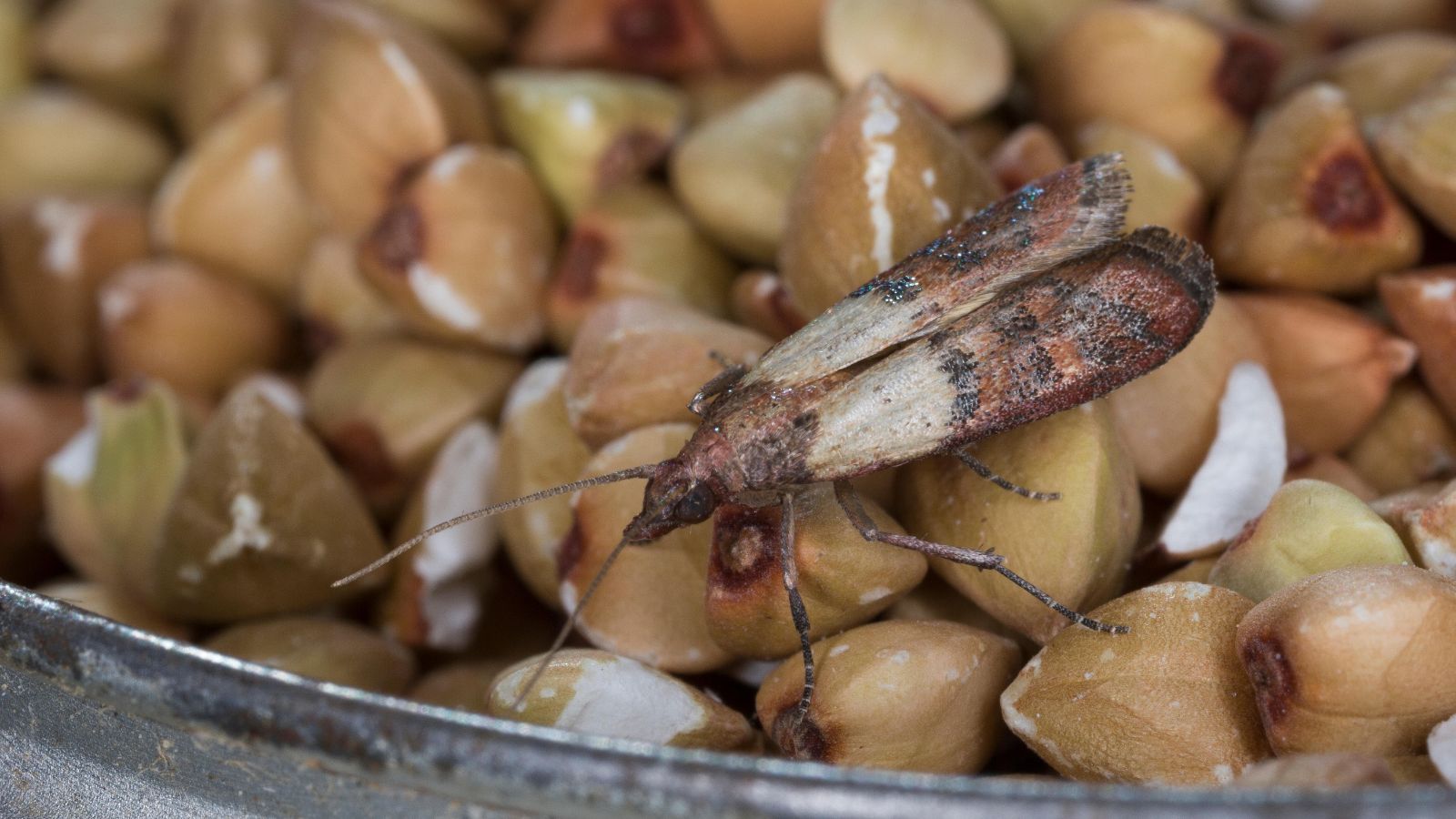
Our pantries can be problematic enough without pests joining in the mix, but when meddling pantry moths make a home in our dried food storage, it is important to deal with them swiftly.
Much like getting rid of ants in the kitchen, getting rid of moths from your pantry should be done quickly and carefully to help preserve your pantry goods and keep your food safe.
Here, professional pest control experts have shared their top tips for getting rid of pantry moths and how to keep them away for good.
How to get rid of pantry moths
It is fairly simple to identify a pantry moth, with a distinctive copper red coloring on its outer wings, six legs, and an elongated oval shape, explains Scot Hodges, A.C.E certified entomologist at Arrow Exterminators. Measuring less than three-fourths of an inch long, these pests are attracted to a large range of dried food products such as dried fruits, grains, seeds, nuts, chocolate, and pet food amongst other things which they then feed on and create nests out of – hence the common name, pantry moth, Scot continues.
Here is how to get rid of these problematic pests before they contaminate your foodstuffs with droppings and eggs and cause otherwise preventable illnesses.

1. Inspect your dried food packages and throw out infested foods
Although time-consuming, it is vital that you take everything out of your pantry and check the contents for any signs of infestation or larvae, says Trent Copperfield, vice president of On Demand Pest Control. This will be simpler if you regularly organize your pantry.
Any products that have been contaminated by the moths should be disposed of, but you should avoid doing so into your regular trash bin, Trent warns. ‘This may not prevent them from spreading further. Instead, consider taking them outside with the trash right away, moving your outdoor trash bin away from the exterior walls, doors, and windows of your home to avoid encouraging them back in.’
2. Vacuum your pantry to remove crumbs and debris
Vacuum cleaners are great for keeping more than your floors clean. Spaces such as pantries are particularly prone to crumbs which can attract pests. Vacuuming can help to quickly collect all of this debris, along with any dead bugs, webbing, and larvae, that are littering your shelves without the risk of them dropping to the floor, points out Olga Gladkaya, pest control expert at Pest Control Plus
‘Make sure to pay particular attention to cracks and crevices where moths and their eggs may be hiding,’ they add.
3. Clean shelving and doors with warm, soapy water
There are plenty of pantry cleaning hacks to speed up the cleaning process, but when dealing with pests there is little better than taking your time with some warm soapy water.
Pest control expert Trent Copperfield urges you to remember to wipe down the walls, shelves, and underside of shelves when cleaning for pests to remove any pests, webbing, and larvae. ‘Once you've cleaned the pantry, inspect everything before putting it back into the pantry, making sure any open packages are sealed up,’ he advises.
4. Consider a moth trap to catch any remaining pests
Once you have cleaned out your pantry, Bary Bryant, ‘bugspert’ at Bill Clark Pest Control suggests that you add in a moth trap, or try your hand at making your own homemade moth repellent to help tackle any lingering pests.
Usually in the form of a pheromone trap, these small additions attract moths to one spot, making them easier to remove all in one go,’ he explains.
How to prevent pantry moths

Preventing pantry moths is a lot less effort than trying to get rid of them once they have established a home.
1. Keep food in sealed containers
Decanting food goods is more than just a trendy fad, it is a great way of preventing pests from infiltrating your pantry, says Olga Gladkaya, pest control expert. Sealed, airtight containers made from durable materials such as glass or plastic are best for this, they add. ‘This will keep pantry moths out and prevent them from laying their eggs. What’s more, taking away access to their food source will prevent them from entering your pantry in the first place than solving the problem at the source.
These smaller glass storage boxes are an eco-alternative for leftovers that keep food fresher for longer.
This large glass jar has an airtight wooden lid, making it a stylish storage alternative for dried food goods.
These highly-rated containers from Rubbermaid are an extremely functional pick with airtight seals.
2. Keep bulk food containers and pantries clean
It should go without saying that keeping your containers and pantry clean will also help to deter pests from setting up a home in your cabinets. Making sure you clean a kitchen properly and regularly, working into the backs of deep cabinets and corners too will help to catch any alluring food spills before it brings a whole host of wildlife into your kitchen.
3. Use up old products first before replacing them
Bulk buying is often a more affordable way to shop, but topping up half-empty containers and opening new packets before finishing old ones encourages pests as food deteriorates or goes off.
‘The longer a food sits in your pantry, the higher the chances it could become infested,’ reminds Brian Valentin of Turner Pest Control, ‘so use your opened products as quickly as you can. If possible, it might be better to purchase smaller quantities of dried products, rather than bulk products that will take months to use up,’ he adds.
4. Check new foods for pests when decanting
Just because you have just bought something new from a store, doesn't mean it is 100% guaranteed to be free from pantry moths – although it is very rare that this would be the case.
‘It is always a good idea to shop at clean stores – if any spillage is present in and around shelving, the chances of purchasing an infested food product goes up,’ explains Craig Sansig, public health entomologist at Viking Pest Control. ‘Check packages as you open them, if a newly infested food is brought into the home, you should notify the store it was purchased at immediately.’
FAQs
Which months of the year do moths appear?
Moths can appear at any time of year, but they are most common as the weather begins to warm up in April and May, and again when it becomes more humid in August and September. Any warm environment such as the inside of our homes offers an ideal breeding ground, however, meaning no indoor environment is truly free from the risk of a moth infestation.
When should I be worried about moths?
You should start to become worried about moths in your home when you see noticeable signs of a bigger infestation. One or two moths in your home after you have had your windows and doors open is not uncommon, however, more moths, moths appearing when your windows have been closed, or holes in your clothing or moths inside cabinets are a sign of a larger infestation that needs your immediate attention.
Pests in a kitchen can be a headache, but they are, more often than not, simple to get rid of yourself with some basic hygiene practices and a little vigilance. Should your pest infestation continue beyond completing these steps, it may be a good time to call in a professional pest control expert who can assess your situation and suggest alternative approaches to freeing your pantry from moths.







